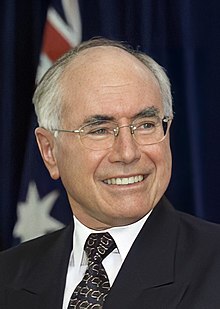
Back John Howard Afrikaans جون هوارد (سياسي) Arabic جون هوارد (محامى) ARZ Джон Говард Byelorussian Джон Гаўард BE-X-OLD John Howard Breton John Winston Howard Catalan جۆن ھۆوارد CKB John Howard Czech John Howard Welsh
John Howard | |
|---|---|
 Howard c. 2001 | |
| 25th Prime Minister of Australia | |
| In office 11 March 1996 – 3 December 2007 | |
| Monarch | Elizabeth II |
| Governor-General | Sir William Deane Peter Hollingworth Michael Jeffery |
| Deputy | Tim Fischer John Anderson Mark Vaile |
| Preceded by | Paul Keating |
| Succeeded by | Kevin Rudd |
| 29th Treasurer of Australia | |
| In office 19 November 1977 – 11 March 1983 | |
| Prime Minister | Malcolm Fraser |
| Preceded by | Phillip Lynch |
| Succeeded by | Paul Keating |
| 22nd Leader of the Opposition | |
| In office 5 September 1985 – 9 May 1989 | |
| Deputy | Neil Brown Andrew Peacock |
| Preceded by | Andrew Peacock |
| Succeeded by | Andrew Peacock |
| In office 30 January 1995 – 11 March 1996 | |
| Deputy | Peter Costello |
| Preceded by | Alexander Downer |
| Succeeded by | Kim Beazley |
| Member of the Australian Parliament for Bennelong | |
| In office 18 May 1974 – 24 November 2007 | |
| Preceded by | John Cramer |
| Succeeded by | Maxine McKew |
| Personal details | |
| Born | 26 July 1939 Sydney, New South Wales |
| Political party | Liberal |
| Other political affiliations | Coalition |
| Spouse(s) | Janette Parker |
| Children | 3 |
| Alma mater | University of Sydney |
| Signature | |
John Winston Howard (born 26 July 1939)[1] is a former Australian politician who was the 25th Prime Minister of Australia from 11 March 1996 to 3 December 2007.[2] John Howard is the second longest serving prime minister of Australia after Robert Menzies. John Howard is a member of the Liberal Party.
John Howard was a lawyer before he became a politician.[1] He was in parliament from 1974 until 2007. From 1977 to 1983 he was the Treasurer in Malcolm Fraser's government.[1] Malcolm Fraser lost the 1987 election to Bob Hawke. On 24 November 2007, John Howard lost to Kevin Rudd and his parliamentary seat to Maxine McKew. He became the second prime minister to lose a parliamentary seat after Stanley Bruce in 1929.
- ↑ 1.0 1.1 1.2 "Australia's Prime Ministers - Fast Facts - Howard". primeministers.naa.gov.au. Archived from the original on 15 May 2009. Retrieved 12 March 2009.
- ↑ "Australia's Prime Ministers - Meet a PM - Howard". primeministers.naa.gov.au. Archived from the original on 15 October 2004. Retrieved 12 March 2009.